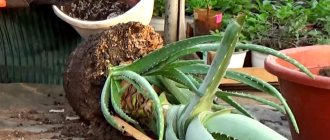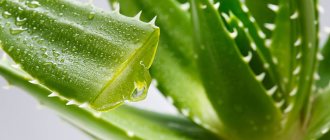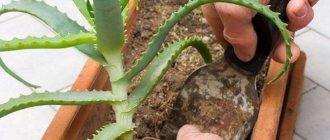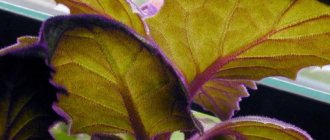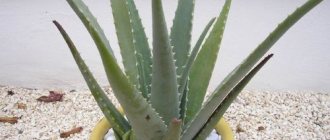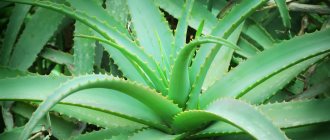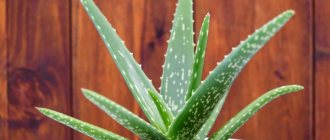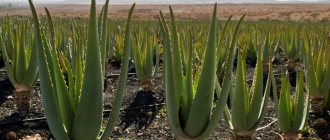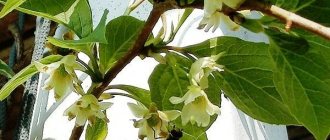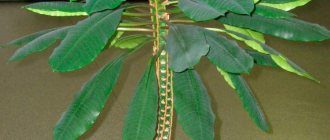Details about aloe variegated (tiger)
Aloe variegated or tiger is an ornamental plant that is grown in flowerpots and in open ground. The succulent got its name due to the peculiar coloring of the leaves, on which contrasting white stripes or spots are formed.
Appearance of a young plant
Variegated aloe is unpretentious to soil and natural conditions and grows well in different climatic zones. Caring for it at home is also quite easy. The plant does not require frequent watering and thrives both on a sunny windowsill and in dimly lit rooms. Aloe variegated is one of the few species that bloom at home, however, the first inflorescences appear only in the 4-6th year of the succulent’s life.
In folk medicine, it is believed that the juice from the leaves of aloe variegated has bactericidal properties and promotes the healing of wounds on the skin. However, this data has not been scientifically confirmed, so the benefits of the plant remain only speculative. For medicinal purposes, juice or tincture from the leaves of aloe vera, homemade or tree-like, as well as occasionally striped and several other species, is used. The properties of aloe vera have been studied the most. Variegated is grown only as an ornamental plant.
Medicinal and beneficial properties
The diverse and rich chemical composition of variegated aloe:
- Amino acids – glycine, licine.
- Polysaccharides.
- Flavonoids.
- Minerals - iron, chlorine, zinc.
- Vitamins – ascorbic acid, carotene, vitamin B.
In pharmacology, the juice of the plant is used to produce bactericidal preparations for abscesses and other skin inflammations. In medicine it is used as a diuretic. Preparations based on natural raw materials are used for eye inflammation and runny nose. Aloe juice is used internally for digestive disorders .
In folk medicine, a leaf cut in half is applied to wounds and abrasions. The juice has healing properties. For cosmetic purposes against acne, masks and tonics based on plant juice are used.
Tips for caring for aloe (agave)
Like most succulents, scarlet is a fairly hardy and unpretentious plant. There are no particular difficulties in caring for agave; it is enough to follow the most general rules for caring for succulent plants.
Illumination. The scarlet plant is light-loving, prefers southern windows, but will not disappear in the shade - in dark rooms the aloe stretches out and becomes pale.
In the summer months, it is recommended to take the aloe to the balcony, but protect it from rain. Plants grown outdoors differ from window aloe in having more powerful spines and better formed stems.
Watering. In summer, water moderately, in winter very rarely with water at room temperature or a few degrees warmer. With a lack of watering, the leaves become thin and contain little juice.
The plant has thick roots, often occupying the entire space of the pot. Water quickly flows into the pan, so it makes sense to water it from below, from the pan. The thinnest roots are located at the bottom of the pot, and they absorb water. Half an hour after watering, the remaining water in the pan must be poured out so as not to cause rotting of the roots.
Air humidity. Doesn't play a significant role. It is useful to occasionally take a warm shower to clean the leaves.
Temperature. Temperatures should be moderate in summer and cool in winter. During the summer months, it is better to place aloe in fresh air.
Almost all succulent plants from arid regions with a continental climate tolerate temperature changes well. Aloe can withstand temperatures up to plus 6 degrees, but some types of aloe are more capricious, they need a temperature of at least 15 °C.
Feeding. It is enough to fertilize aloe once a month in spring and summer with a weak solution of mineral fertilizer for cacti and succulents. From mid-autumn and winter they do not feed.
Transfer. Young aloe plants are replanted annually, adults - after 2-3 years as needed. The pots are deep, drainage is required.
Soil You can use a ready-made mixture for cacti and other succulents. It is advisable to add charcoal and brick chips.
If you prepare the mixture yourself, then a mixture of turf soil, leaf soil, humus and sand (2:1:1:1) with the addition of red brick crumbs and charcoal is suitable. It is better not to add peat. The soil reaction should be slightly acidic.
Reproduction. It is not difficult to propagate aloe; you can do this by root shoots, apical and stem cuttings, as well as seeds. After harvesting the cuttings, they need to be slightly dried, maybe several hours or even 1-2 days.
The root shoots and cuttings are planted in a substrate of sand and leaf soil (1:1), deepening them to 1 cm. The cuttings are watered quite rarely. There is enough moisture in the leaves, you just need to make sure that the substrate is slightly damp. As soon as the cuttings take root, watering is increased, which promotes active growth of the plant.
Seeds can only be propagated by purchased ones, because aloe blooms very rarely in indoor cultivation.
Pests. It is rarely affected by diseases and pests, but sometimes scale insects can settle on aloe. A soap solution used to wipe the leaves will help get rid of pests.
Home care
Temperature
Variegated aloe does well at room temperature. In summer, the optimal temperature is up to 22 °C. You can take the pots out onto an open loggia or veranda. The flower loves fresh air, but does not tolerate drafts.
In autumn and winter, at rest, the air temperature should be reduced to 10 - 12 °C.
Watering
The flower should be watered moderately, regularly, once a week in the spring and summer.
In winter, watering is reduced; light moistening of the substrate is sufficient once every 3–4 weeks. This variety requires low air humidity up to 40%. The flower does not need spraying. In the summer heat, it is advisable to wipe the leaves with a damp cloth to remove dust once a week.
When watering, water should not fall on the leaves and into the outlet; it should be poured under the root. Watering should be done with warm, settled water.
Light
Aloe Variegata loves well-lit places. You can install pots on south-facing windows. At lunchtime, it is better to shade the windows with a light curtain.
In winter, additional lighting for 3 hours a day is desirable.
Trimming
This flower does not need form-building trimmings from the bush.
After flowering, it is necessary to trim off the dried flower stalks. Old, yellowed, lower leaves are also cut off.
Feeding
Fertilizers are applied during the active phase of flower growth, in spring and summer, once a week. In autumn, fertilizing is reduced; it is enough to apply fertilizer once a month.
Special complex mineral fertilizers for succulents are used as fertilizers. Flower growers recommend using ash, humus, and vegetable decoctions as organic fertilizers. Liquid fertilizers are applied through irrigation. Immediately after transplantation, fertilizers are not applied for 2–3 weeks.
Pot
For planting adult flowers, it is recommended to use ceramic or clay pots. As the root grows with age, the plastic pot may tip over. Young seedlings can be planted in plastic flowerpots until they are 2–3 years old.
Planting containers must have drainage holes for good air permeability. The pot should not be very deep, but spacious and wide.
Transfer
For replanting, you must first prepare special soil. The soil should be light, loose, well drained. It is better to purchase a special mixture for succulents in the store. You can prepare the soil mixture at home.
Soil composition for variegated aloe:
Rotted compost - 1 tsp. Coarse sand - 1 tsp. Drainage.
You can also use a mixture of turf soil, leaf soil, sand, in a ratio of 2:1:1.
Flowers are usually replanted in the spring. Young bushes require annual replanting, adult plants are replanted once every 2 to 3 years.
Transplantation scheme:
A drainage layer 2 cm high is poured onto the bottom. Soil is poured in. The substrate is moistened. Transplantation is carried out using the transshipment method, the flower is transferred to the pot along with a lump of earth. Air temperature - up to 20 ° C. Soil moistening is regular, in small doses.
We recommend watching a video about transplanting variegated (tiger) aloe:
Decorative forms
Experts have bred many different varieties of aloe for cultivation for decorative purposes. However, non-selective species can also be grown at home, since even large plants rarely grow to large sizes at home.
If you want to decorate a windowsill or desktop with a miniature plant that does not require frequent watering and special care, you can pay attention to small succulents. These are, for example, the following types of aloe:
- Haworthiform;
- Short-leaved;
- Rauha;
- Squat;
- Squarrosa;
- Bruma;
- Descuana.
Aloe haworthioides looks very interesting and unusual. Without knowing that this plant belongs to the Aloe genus, it is almost impossible to guess.
And this is what aloe Pepe looks like (hybrid Aloe Pepe):
It was obtained by crossing two types of succulents - Descouan and Haworthiaceae.
The Black Jam variety is no less interesting:
With prolonged exposure to the sun, the leaves of this succulent become burgundy in color.
Aloe brevifolia grows the same shape and height, but its leaves are larger, broadly lanceolate, as can be seen in the photo below:
A peculiarity of this species is that the leaves can take on a reddish color under certain conditions. Aloe rauhii also has the same property:
This plant has thin and elongated leaves, united in rosettes with a diameter of about 10 cm. They are covered with small longitudinal spots over the entire surface, and with thorns along the edges.
Artificially bred varieties of this plant are often grown for decorative purposes: Snow Flake, Winter Sky and White Cloud. The first is distinguished by more pronounced white dots, the second by the larger size of the leaves, and the third has an almost white color.
Snow Flake
Winter Sky
White Cloud
Aloe humilis also grows to approximately 20 cm, in rare cases – up to 25-30 cm. An adult plant looks like this:
Its leaves are lanceolate, reaching a length of up to 10 cm and a width of 1.5 cm. Their color can vary from gray-green to gray-blue. The leaves are covered with small thorns on top. The succulent blooms in summer and often even at home.
Aloe squarrosa, whose second name is juvenna, grows up to 30 cm. It is a shrubby plant with a shortened stem. Its leaves are broadly lanceolate, covered with numerous spines.
One of the smallest is Aloe broomii. The height of this plant does not exceed 15 cm. Its leaves are large, lanceolate, with sharp spines along the edges.
The smallest is considered to be Aloe descoingsii. The length of its leaves, collected in compact rosettes, does not exceed 2-4 cm. The succulent grows very slowly, and it takes at least 5 years to form a plant of 4-7 rosettes.
Other decorative forms of these succulents can grow up to 40-60 cm. These plants are grown not only in flowerpots, but also in open ground.
Black-thorned aloe (Aloe melanacantha) grows up to 50 cm. It has large leaves of a deltoid-lanceolate shape, growing up to 20 cm in length and up to 4 cm in width. You can determine the type of plant by the thorns, which are located not only along the edges, but also and on the back of the leaves. The photograph shows that the upper spines are almost black in color, which is why the plant got its name.
A more powerful bush is formed by Aloe perfoliata. Although it also only grows up to half a meter, due to the larger number of leaves the bush appears more voluminous. Like the previous species, it has thorns on the back of the leaves, but they are located only near the tip and are white in color.
Aloe cap-shaped (Aloe mitriformis mill) has a similar appearance. Its leaves are also gray-green, but the spines located on the sides and top are completely white and soft. The height of a succulent can grow from 40 to 100 cm.
Aloe mitriformis f. variegata
This photo shows a young aloe cap:
And this is a hybrid obtained by crossing two species - cap-shaped and variegata (aloe mitriformis x nobilis variegata)
Description
Gonialoe variegata is a small succulent without stems, up to 30 cm high and up to 25 cm wide, with 16-26 smooth dark green, unevenly variegated leaves, growing in three rows from the center to the edge, 6-8 in each row. The variegation of the leaves is given by lighter transverse group lined inclusions, reminiscent of tiger stripes - the darker areas are successively replaced by light green ones. The leaves can reach a length of 20 cm and a width of up to 6 cm, the edges are sporadically armed with white teeth. If there is a lack of moisture, the foliage may become reddish in color, and if there is a long absence of water, it may become light brown.
Flowering begins in late spring, in the fifth year of life. The peduncles are large, up to 45 cm in length, mostly branched, ending in cone-like inflorescences. The flowers are elongated, about 2.5 cm, tubular with six petals, the average number in an inflorescence is about 30. The flowering period lasts from July to September. The flowers are usually orange with a greenish edge, but colors can range from flesh pink to dull red and rarely yellow.
The root system is developed, fibrous, with adventitious processes oval in diameter. The average lifespan of a plant is 15-20 years.
This attractive succulent was first discovered on October 16, 1685 on the Namaqualand plateau during Simon Van Der Stell's expedition to South Africa. Most often in the wild, Tiger Aloe can be found in arid or semi-arid regions of the Republic of South Africa and southern Namibia. Since its discovery, it has enjoyed constant popularity among residents of Europe, where it is cultivated as a houseplant and garden plant (in the southern regions).
Growing Tiger Aloe
The succulent is very patient with various procedures associated with planting, propagation and care. In general, this is an unpretentious plant that beginner gardeners can safely grow. The rules of transplantation can be mastered even by a person who is far from floriculture.
Choosing a pot for variegated aloe
To grow tiger aloe, choose heavy ceramic containers with drainage holes in the bottom. While the plant is small, it grows quietly in a small plastic pot, but with age its above-ground mass increases and becomes weighty, leaning over the edge of the pot. Therefore, it needs a stable container, and the root system of the succulent is well developed, and the root ball takes up a lot of space.
Preparing the soil and planting tiger aloe
The substrate for planting is purchased at a flower shop - any soil mixture for cacti or succulents with a slightly acidic or neutral soil reaction (5.0–7.0) is suitable. It’s not difficult to prepare it yourself; just take 2 parts of turf soil and 1 part each of sand and leaf humus. A drainage layer of expanded clay or crushed stone 2–3 cm thick is laid at the bottom.
Young plants are placed in the center, and adults with a clear direction for growing the rosette are planted closer to the wall of the vessel opposite the growth vector. The root collar is placed at soil level, and in no case is it deeply buried in the substrate - in variegated aloe this is the most vulnerable place, primarily suffering from the very first unfavorable environmental conditions.
Accommodation in an apartment according to the requirements for heat and light
Aloe tiger is placed in the brightest place in the house; it is not afraid of direct sunlight, except during intense heat with temperatures exceeding 30–35 degrees above zero for a long period - the plant can get burns on the foliage.
In summer it grows well in the open air of balconies and terraces, but with the arrival of cold nights the succulent must be returned to the house, because the succulent cannot withstand temperature drops of less than 5 degrees Celsius. To ensure the establishment of flower stalks, aloe variegata is kept in a moderately heated room in winter with a thermometer reading of 12–18 degrees above zero.
Description of succulents of the genus Aloe
Many ordinary people, having heard the word Aloe or Agave, immediately remember a small rosette plant growing in a pot near the window. But in fact, this genus is currently represented by about 600 species, each with its own characteristics and amazing appearance.
The genus name "Aloe" comes from the Arabic word Alloeh, which means "shining bitter substance". The name was given because of the bitter sap of the plant's leaves. The first mention of the succulent comes to us from Sumerian clay tablets 4000 years ago, where Aloe was depicted as a useful flower for digestion and healing.
The Aloe genus was recently transferred to the Asphodelaceae family after many years in the Liliaceae family.
How long does Aloe live and where does it grow?
These are mostly long-lived plants, especially large species. Aloe dichotomis is estimated to be 100–145 years old, and some exceptionally tall varieties, such as Aloe marlothii, which grows over 10 m, may even be over 200 years old.
Photo of Aloe marlothii in the African desert
Most plants of the genus are distributed in the Cape Province of South Africa, in the mountains of tropical Africa, as well as in neighboring regions such as the island of Madagascar, the Arabian Peninsula and the islands off the coast of Africa. Some species have become naturalized in other regions and continents.
It is often thought that Aloe only grows in hot, arid climates, but in fact they grow in a wide variety of climate zones, such as deserts, grasslands, coastal locations and even mountains. For example, one of the most beautiful of all species of the genus, Aloe polyphylla, is found at an altitude of 3500 meters above sea level in the Drakensberg Bay of the Lesotho mountains.
Photo of a succulent on a mountainside
In most cases, Aloe grows in rocky or gravelly soils, but they can also grow in richer soils among grasses, among cracks in rocks or in sand. The succulent usually grows in open areas if the sun is so intense, or under the shade of shrubs or trees that are used as protection. Most often the population of a single Aloe species is small, although sometimes they can be the dominant plant in an area.
Features of succulents of the genus Aloe
These plants survive in harsh environments thanks to several important adaptations to their environment. They use a special type of photosynthesis called CAM (Crassulacean Acid Metabolism), which minimizes water loss. In “normal” plants, pores (called stomata) act as ventilation, absorbing carbon dioxide, and also releasing water to cool the surface of the leaves. In very hot climates, the large amount of water that can escape through the pores causes the plants to dry out. But they must keep these pores open to collect the carbon dioxide needed for photosynthesis.
Aloe's stomata open only at night. Thus, the plant receives as much carbon dioxide as it needs for photosynthesis while minimizing water loss through the pores. Carbon dioxide is stored overnight until the next day, when the first rays of the sun signal the release of carbon dioxide for photosynthesis.
Another adaptation is Aloe's ability to store relatively large amounts of water in its leaves, so it will have a reserve of moisture during droughts. The waxy coating on the surface of Aloe leaves also helps with moisture loss by minimizing the evaporation of water from cells on the surface of the leaves and limiting water loss in the pores. Wax can also reflect excess light away from the plant. This wax can be seen on the leaves of most aloe plants as a bluish tint.
The sharp thorns and prickles, as well as the bitter sap of the leaves, are good deterrents to leaf consumption by many herbivores.
What does an Aloe plant look like?
Succulents come in many varieties, from small dwarf plants to tall single-trunked or branched trees, and some species even form large, dense clumps of bushes. The fleshy, succulent leaves are more or less spear- or sword-shaped. The leaves are collected in rosettes and have usually sharp, but often soft teeth along the edges.
Most members of this genus have a rosette of leaves at the base but no stem. There are also species that have long branched stems.
The flowers are grouped into candle-shaped or cone-shaped inflorescences that can be branched or simple. The most common form of flowers found in Aloe are tubular flowers, although some species have curved or even bell-shaped flowers. They are usually brightly colored and most often come in various shades of red, orange and yellow, but there are also some species with green, pink or white flowers. The vast majority of plants bloom in winter, while some species bloom in spring or summer.
Succulent fruits are capsules that dry and split open to release small, ripe, brown to black seeds.
It is important to know that some Aloe species are poisonous.
How to grow aloe variegation at home
You can grow aloe at home from seeds or cuttings, but this requires certain skills in caring for flowers. For those who do not have them, it is easier to buy a small plant in a flowerpot. Since aloe variegation is a fairly common plant, it can be purchased in Moscow and other Russian cities at fairly low prices.
Tiger aloe seeds are stratified before planting. To do this, they are soaked for several weeks in a weakly concentrated solution of potassium permanganate. After this, the seeds are sown in moist soil, on top of which glass is placed. Place the container with seeds in a sunny place.
The dark films around the seeds are a special device that facilitates their transfer by the wind.
If all conditions are met, after three weeks the seeds germinate, after which the glass is removed from the soil. When the seedlings grow a little, the young plants are transplanted into separate flowerpots.
Young shoots in the leaf axils.
To form cuttings, the apical or lateral shoots are cut off. They are left without water or soil for two days so that the cut area dries out a little. After this, the cuttings are planted in special soil so that they take root. Some experts recommend slightly moistening the soil before planting, and then not watering the plant for the first 7 days, but spraying it with a spray bottle. Others, on the contrary, advise regularly watering aloe so that the soil does not dry out.
This video shows the step-by-step process of replanting a plant:
Given that aloe loves the sun, during rooting of cuttings the flowerpot should be placed in a warm place, but so that direct sunlight does not fall on it. After rooting, aloe can be placed on a sunny windowsill.
Aloe loves sunlight. If a plant doesn't get enough light, its leaves may become duller or narrower and elongated. In this case, the flowerpot needs to be moved to a sunny place to save the plant from death.
The soil for growing aloe is slightly acidic or neutral with a pH level of 5 to 7. Sometimes ready-made mixtures intended for growing succulents are used. When preparing the soil yourself, mix turf and leaf soil, humus, peat and sand, adding to them a little crushed charcoal and brick chips. Mix the components in a ratio of 2:1:1:1:1.
On a note
If your aloe is growing very slowly, the soil may be too heavy for it. In this case, the succulent is replanted by adding more sand to the soil.
Young aloe is planted in a flowerpot with a diameter of 10-15 cm. Since the root system of the succulent is powerful and grows quickly, aloe is replanted every year in the spring. A fully mature plant does not need such frequent replanting. It is replanted every 2-3 years, slightly increasing the diameter of the pot
At the same time, it is important to ensure that the roots of the plant do not rest against its walls, but have room to grow
Aloe needs to be watered quite rarely. In summer, one watering per week is often sufficient. On particularly hot days, the plant can be sprayed. You also need to make sure that the soil does not dry out too much. In this case, you can water the succulent more often than once a week, but do not forget that this plant does not tolerate waterlogging and may die as a result.
In winter, aloe begins a dormant period. With the onset of cold weather and decreasing daylight hours, watering the succulent should be reduced to 1-2 times a month. At this time, it is also advisable to move the flowerpot to a room with a constant temperature of 10-15 °C.
Aloe can be fertilized only six months after transplantation. Fertilizing is carried out with special fertilizers for succulents, which are applied to the soil after watering. It is useful to fertilize the plant only in the summer during the period of active growth.
A hybrid bush with an unusual color - its spots on the leaves do not form stripes.
This variety of succulents is practically not susceptible to diseases and pests. In rare cases, scale insects may appear on the plant. Their appearance is indicated by gray or brown oval spots on the leaves. To get rid of parasites, special products are used that can be purchased at florist stores.
How to propagate indoor Aloe
Most species of the genus are propagated by three methods - seeds, stem cuttings and side shoots or offspring. These methods are effective and widely used in nurseries, greenhouses and at home. Let's look at all the methods in more detail.
Propagation by seeds
Seed germination usually begins within one week after sowing. Seeds should be collected after flowering, as soon as the capsules dry and begin to open, and sown as fresh as possible.
Use a mixture containing equal parts sifted compost or leaf soil and coarse river sand. Sow the seeds over the surface and cover with a very thin layer of soil or clean sand. Place a pea-sized layer of gravel on top.
The gravel will later serve as a support for germinating seedlings with a very weak root system. The tray with seeds must be moistened, ventilated and kept at a daily temperature of about 20 °C. In nature, young plants are usually in the shade of neighboring plants. Try to imitate these conditions by placing trays of seedlings in the shade.
Remember! During the first few months, the young shoots are very tender and must be handled carefully.
As soon as the sprouts are strong enough (about 3 months), they can be transplanted into separate pots.
Propagation by stem cuttings
A popular and reliable method of propagating woody and branching Aloe species. Cut off the top of the stem with a rosette and set the cutting aside for a couple of days in a dry place.
You need to let the cut area tighten. Then plant the cutting in a prepared container with fresh soil mixture. You need to care for the seedlings like you would an ordinary succulent.
Plants grown from cuttings reach maturity faster than plants grown from seeds.
Reproduction by children
Rosette species of Aloe, which do not have a stem, form large clusters of many rosettes, can be propagated by dividing them into individual plants. Children should be removed from the mother plant with a sharp knife. They should also be left to dry in the shade before planting, especially if the shoots do not yet have their own roots. Plants that have already formed roots can be planted in ordinary pots - they take root faster than rootless shoots. As with cuttings, plants grown from side shoots reach maturity more quickly than plants grown from seeds.
Features of aloe
The leaf blades of aloe, which are part of the rosette, grow from the root; as a rule, they are fleshy. There are species that have thorns on the foliage, and there are also those that simply do not have them. Some species have a waxy coating on the surface of the foliage. During the flowering period, the bush is decorated with flowers of red, yellow or orange. The shape of the inflorescence, depending on the species, can be racemose or paniculate, often the flowers are bell-shaped or tubular.
Some species have healing properties, so they are used in alternative medicine. Aloe juice helps to quickly cure ulcers and burns. It is also used to make masks because it has restorative and rejuvenating properties. The foliage is used to obtain a substance distinguished by its laxative effect. Not only many types of aloe are grown in culture, but also varieties.
Aloe care
Experienced gardeners share some recommendations for caring for plants:
- It is necessary to organize proper watering of aloe at home. Watering is not done often. In summer, water moderately once a week. In cool weather, watering is reduced to twice a month. To avoid water stagnation, you need to use drainage, maintain a water temperature for irrigation of at least +25 °C, and be sure to use a tray with liquid.
- Regularly (from spring to autumn) feed the plant twice a month. Fertilizer for aloe should be specifically selected for succulents or cacti.
- Regularly spray the leaves of the plant and the air around them. Dry indoor air is very harmful to aloe.
- In winter, you need to try to ensure peace for the plant. Stop feeding, do not replant and water less.
- The room should be regularly ventilated, but without drafts.
- In the fall, be sure to carry out sanitary pruning. Removing dry and diseased leaves. Those leaves that have lost their bright color also need to be removed.
- Seed the plant regularly to avoid sprouts growing haphazardly in the pot.
- From time to time you can use complex mineral fertilizers for indoor crops. Excessive, unsystematic feeding can damage aloe.
- It is necessary to regularly and carefully inspect the young plant for the presence of harmful insects. Aloe can be affected by scale insects and spider mites. When the first signs of infection are detected, the plant must be treated immediately. For example, spray with a solution of laundry soap or a weak solution of vinegar. To completely free the plant from insects, it will be necessary to carry out repeated treatment with insecticides.
- No less dangerous pests for aloe are mealybugs and thrips. It is necessary to spray the plants with the biological product “Fitosporin”.
- Protect young plants from diseases. They can get fungal diseases. Dark green spots will appear on the plant. In this case, you will have to treat the plant with an antifungal agent.
These valuable recommendations from gardeners will tell you how to care for aloe at home.
Aloe vera is a plant that does not require particularly close attention to make caring for it at home a pleasure.
